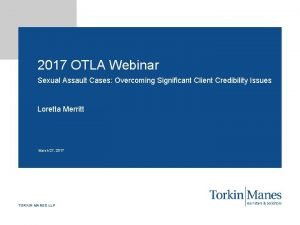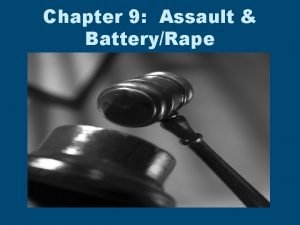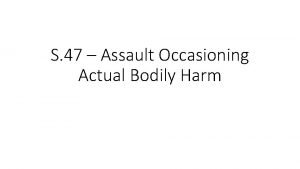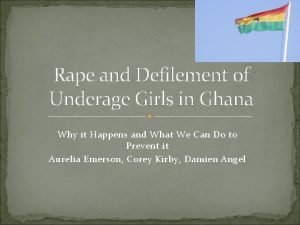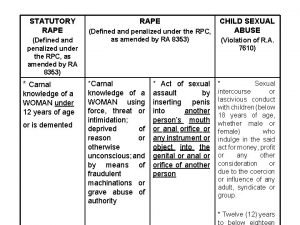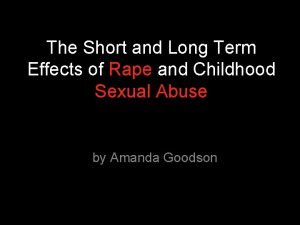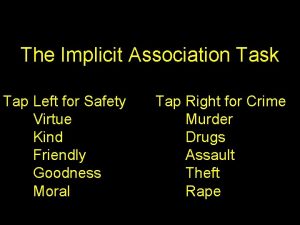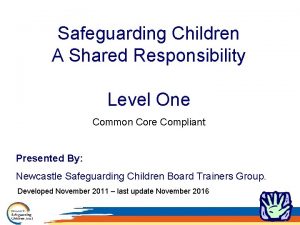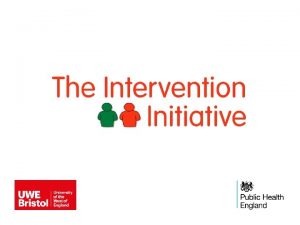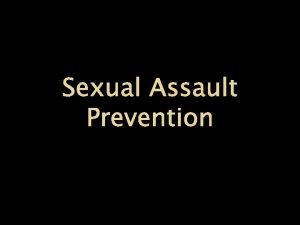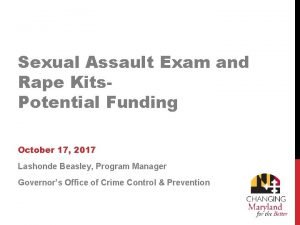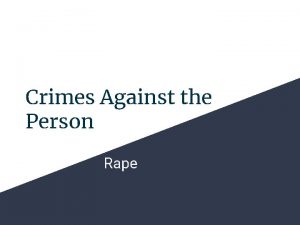Session Three Rape and Sexual Assault We will












































- Slides: 44


Session Three Rape and Sexual Assault

• We will be learning and working together as a group in this programme • Some of the material we will be discussing will be sensitive and some of us will have had personal experience of the things we discuss • We will all be be respectful of personal emotions as we learn Some ground rules • • Confidentiality Appropriate language Attendance Communicating with the facilitator Please be aware that we will be talking about sensitive issues and issues that might have affected you or people you care about. If you feel uncomfortable or upset it is fine to leave the space. Facilitators will understand are trained to help you.

This is a bystander programme: EMPOWERING YOU AS BYSTANDERS TO INTERVENE TO PREVENT VIOLENCE

4 Stages for intervention 1. Notice the event 2. Interpret it as a problem 3. Feel responsible for dealing with it 4. Possess necessary skills to act (Adapted from Berkowitz, A. (2009) Response Ability: A Complete Guide to Bystander Intervention, Beck & Co. , p. 10)

Stage 1: Noticing behaviour or an event We need to understand learn about rape and sexual assault in order to be able to notice situations and see behaviours or events as potentially problematic.

What percentage of rapes are committed by someone known to the victim? A. • 35% B. • 71% C. • 85%

FACTS Rape is rarely committed by strangers: 85 percent of reported rapes are carried out by someone known to the victim (HMIC, 2007) NUS survey found that the majority of perpetrators of stalking, sexual assault and physical violence were already known to the victim (NUS 2011 p. 19)

‘A rape victim will resist and fight the attacker and there will be signs of injury. ’ A. • Agree B. • Disagree C. • Unsure

Victim Resistance • How do victims of rape resist? – Physical resistance • Fighting, hitting, struggling, running away – Verbal resistance • Telling the perpetrator(s) to stop, persuasion, shouting, screaming • Not all victims resist. Why is this? • Fear (the ‘freeze fright’ response), the use of weapons, multiple assailants or threats

A student’s experience: questions about masculinity? ‘My main problem was dealing with the fact that men can get raped too. Others said I should have beaten him up or been more of a man or that it was a lesson for being seen as a bit promiscuous at times. ’ (Cambridge 2014 p. 20) Cambridge study: CUSU (Cambridge University Students' Union) (2014). Cambridge Speaks Out. Cambridge: CUSU Women's Campaign. Online at http: //www. womens. cusu. cam. ac. uk/Cambridge%20 Speaks%20 Out%20 Report%202014. pdf

A person who is drunk or using drugs … A. • Should be held responsible if they are sexually assaulted or raped B. • Should be held partly responsible if they are sexually assaulted or raped C. • Are NEVER responsible if they are sexually assaulted or raped

Why rape is not the victim’s fault • Rape is a violation and act of violence with harmful consequences • Responsibility only lies with the perpetrator • Nobody has a right to your body without your consent no matter what you do or how you behave

Discussion point: • Why does it matter if people hold erroneous views (myths) about rape?

For the victim / survivor • • • Self-blame Negative experience of disclosure Unlikely to disclose Unlikely to access support May suffer mental and physical ill health

Experiencing blame ‘I was raped in 2010 … walking back to college late at night. I took him to court and won - but the most harrowing aspect of having been raped was not the attack itself, but the experiences I had afterwards, both in court and with “friends”. I told very few people but I can't count amount of the times I was asked “what were you wearing”, “were you drunk”. Blame culture is despicable and prevalent in even those who think themselves to be well adjusted on such matters … Women, though were the worst. They were the main perpetrators of queries as to what I was wearing at the time, whether I'd led the man on, whether I was drunk. ’ (Cambridge Speaks Out, 2014: http: //www. cambridgespeaksout. org. uk/stories/)

For the criminal justice system No disclosure Disclosure Victim self-blame If offender caught No disclosure / reporting CPS decisions to prosecute or not No Investigation (police unaware) Jury decision-making (guilt or innocence) Repeat offending Judicial decision-making BRINGING OFFENDER TO JUSTICE AND PROTECTING THE PUBLIC

Max penalty life imprisonment LAW OF RAPE: VAGINA Sexual Offences Act 2003 (s. 1) INTENTIONAL PENETRATION by PENIS WITHOUT CONSENT ANUS MOUTH

Sexual Offences Act 2003, s. 74 FREEDOM CHOICE CAPACITY CONSENT

Discussion point: • What do you think consent means?

If a woman does not clearly say ‘No’ to a man then … A. • She should be held responsible if she is sexually assaulted or raped B. • She should be partly held responsible if she is sexually assaulted or raped C. • She is NEVER responsible if she is sexually assaulted or raped

FACTS • The absence of a ‘No’ does not mean that sex is consensual • Someone who is asleep or unconscious cannot consent to sexual activity • Someone who is very drunk or drugged may not have capacity to give consent


As a bystander you might look out for: • Slurred speech or unable to communicate • Falling over • Vomiting • Passing out/in and out of consciousness

Credit: University of Warwick

FACT 8% of respondents to the student survey had sexual intercourse ‘when they didn’t want to’ because they were or felt unable to say ‘no’ (NUS 2011 p. 16) NUS study: NUS (National Union of Students) (2011) (2 nd Ed. ). Hidden Marks. London: NUS. Online at http: //www. nus. org. uk/Global/NUS_hidden_marks_report_2 nd_edition_web. pdf

Video: Tea Consent

Sexual Assault by Penetration Sexual Offences Act 2003 s. 2 Vagina Max penalty life imprisonment Anus Penetration by object or other body part (e. g. fingers) without consent

Sexual Assault Sexual Offences Act 2003 s. 3 Sexual touching without consent e. g. touching breasts, groping, kissing Max penalty 10 years imprisonment

FACT 16% of student respondents have experienced some form of sexual assault (NUS 2011 p. 11) NUS study: NUS (National Union of Students) (2011) (2 nd Ed. ). Hidden Marks. London: NUS. Online at http: //www. nus. org. uk/Global/NUS_hidden_marks_report_2 nd_edition_web. pdf

Other behaviours experienced on campus • 65% of respondents to NUS survey reported verbal harassment e. g. sexual comments, wolf whistling, catcalling (NUS 2011 p. 12) • 12% had experienced stalking (NUS 2011 p. 11) NUS study: NUS (National Union of Students) (2011) (2 nd Ed. ). Hidden Marks. London: NUS. Online at http: //www. nus. org. uk/Global/NUS_hidden_marks_report_2 nd_edition_web. pdf

Stage 2: Interpreting behaviour or an event as a problem • It goes on within your community • Violence is everybody’s problem • The problem has not been solved

Stage 3: Feeling Responsible • You are part of the solution • It hurts people who we care about • It hurts all men because it makes women fear men or their motives

The impact on victims • Short and longer-term reactions may include: - Self blame, depression, fear, avoidance of people or situations, self-harm, trying to ‘forget’ or normalise, leaving university • Factors impacting on recovery include: - The reactions of other people, selfblame, the availability of support

The consequences of offending behaviour • Being labelled and known as an abusive person – Facing friends, family and other students • Possessing a criminal record – Getting a job and impacting future potential – Being on the sex offender register – Public disclosure of a criminal record by the police

Being a friend • Watching out for a friend who could be a potential victim • Watching out for a friend who might be unaware that what they are doing or about to do is a crime • Making someone realise that their behaviour is not acceptable

Social Norms College Men overestimate other men’s College Men underestimate other men’s Belief in rape myths Discomfort with language or behaviour that objectifies or degrades women Willingness to use force to have sex Willingness to intervene to prevent a sexual assault Desire to make sure that they have consent when sexually active (Adapted from Berkowitz, 2011: 167)

The result of misperceptions I’m uncomfortable but I’m the only one 1. Misperceptions inhibit bystander intervention. College men are less likely to intervene when they misperceive other men’s willingness to intervene

2. Misperceptions may facilitate violent and abusive behaviour in those already pre-disposed to it ‘Overestimating the prevalence of sexual assault was associated with greater likelihood of engaging in sexual assault…’ (Neighbors et al 2010 p. 6) Everyone thinks it’s ok ‘[M]en who strongly believe in myths are more likely to act on them and perpetrate sexual assaults when they perceive their male peers to have similar attitudes … [and] less likely to act on them when they correctly perceive that other men are not in agreement. ’ (Berkowitz 2013 p. 21)

You are part of the solution!

What can you do? • How might you challenge the cultural context? • What situations might you notice as they occur? • What situations might you prevent beforehand?



References Berkowitz, A. (2013). A Grassroots’ Guide to Fostering Healthy Norms to Reduce Violence in our Communities: Social Norms Toolkit. USA: CDC. Online at http: //www. alanberkowitz. com/Social_Norms_Violence_Prevention_Toolkit. pdf Berkowitz, A. (2011). “Using How College Men Feel about Being Men and ‘Doing the Right Thing’ to Promote Men’s Development” in Laker, J. and Davis, T. , Masculinities in Higher Education: Theoretical and Practical Considerations. Routledge Neighbors, C. , Walker, D. D. , Mbilinyi, L. F. , O’Rourke, A. , Edleson, J. L. , Zegree, J. , Roffman, R. A. (2010) “Normative misperceptions of abuse among perpetrators of intimate partner abuse”, Violence Against Women, 16(4), 370 -386. HMIC (2007). Without Consent: A report on the joint review of the investigation and prosecution of rape offences. London: HMIC. http: //www. hmcpsi. gov. uk/documents/reports/CJJI_THM/BOTJ/Without_Consent_Thema tic. pdf
 Wasac
Wasac Robert allison sexual assault
Robert allison sexual assault Sexual assault expert witness
Sexual assault expert witness Koko the gorilla sexual assault
Koko the gorilla sexual assault Definition if assault
Definition if assault Assault vs battery examples
Assault vs battery examples Assault vs battery
Assault vs battery Tca 39-13-111
Tca 39-13-111 Assault position
Assault position Obscene and indecent articles ordinance
Obscene and indecent articles ordinance 5 stages of aggression
5 stages of aggression What is abh
What is abh Tadpole diagram air assault
Tadpole diagram air assault Isrr icd10
Isrr icd10 An exercise session has three stages
An exercise session has three stages Who is chrispissa
Who is chrispissa Rape of nanking map
Rape of nanking map Introduction of the rape of the lock
Introduction of the rape of the lock Mary villani bronx science
Mary villani bronx science Rape o
Rape o Rape fantasies margaret atwood
Rape fantasies margaret atwood Rape underage porn
Rape underage porn Dans son vieux pardessus paroles
Dans son vieux pardessus paroles A rape in cyberspace
A rape in cyberspace Say what strange motive goddess
Say what strange motive goddess Statutory rape rpc
Statutory rape rpc The rape of the lock summary
The rape of the lock summary Rape crisis south london
Rape crisis south london Long term effects of rape
Long term effects of rape Rape
Rape Hitler clicker
Hitler clicker Rape of nanking
Rape of nanking Implicit association task
Implicit association task Rape of nanking
Rape of nanking Rape of nanking
Rape of nanking Satire in the rape of the lock
Satire in the rape of the lock גנימדס
גנימדס The rape of the lock canto 5 summary
The rape of the lock canto 5 summary Hobbits and orcs problem psychology
Hobbits and orcs problem psychology Sexual abuse signs and symptoms
Sexual abuse signs and symptoms Section 1 meiosis
Section 1 meiosis Daniel pelka sister
Daniel pelka sister Mendelian genetics
Mendelian genetics Chapter 10 section 3 gene linkage and polyploidy
Chapter 10 section 3 gene linkage and polyploidy Sexual vs asexual reproduction venn diagram
Sexual vs asexual reproduction venn diagram



